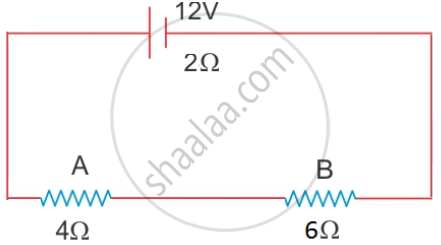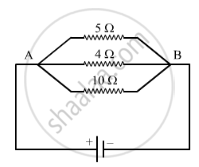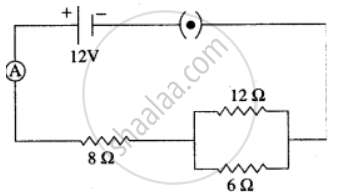Advertisements
Advertisements
Question
How much energy is given to each coulomb of charge passing through a 6 V battery?
Solution
The energy given to each coulomb of charge equals the amount of work done to move it.
Now we know that,
Potential difference = `("Work Done")/("Charge")`
∴ Work done = Potential difference × charge
Where, Charge = 1 C and Potential difference = 6 V
∴ Work done = 6 × 1
= 6 Joule.
APPEARS IN
RELATED QUESTIONS
Name a device that helps to maintain a potential difference across a conductor.
A battery of emf 12 V and internal resistance 2 Ω is connected with two resistors A and B of resistance 4 Ω and 6 Ω respectively joined in series.

Find:
1) Current in the circuit
2) The terminal voltage of the cell
3) The potential difference across 6Ω Resistor
4) Electrical energy spent per minute in the 4Ω resistor.
The values of current (I) flowing through a given resistor of resistance (R), for the corresponding values of potential difference (V) across the resistor are as given below:
| V (volts) | 0.5 | 1.0 | 1.5 | 2.0 | 2.5 | 3.0 | 4.0 | 5.0 |
| I (amperes) | 0.1 | 0.2 | 0.3 | 0.4 | 0.5 | 0.6 | 0.8 | 1.0 |
Plot a graph between current (I) and potential difference (V) and determine the resistance (R) of the resistor.
What do you understand by the term "electric potential"? (or potential) at a point? What is the unit of electric potential?
How much energy is transferred by a 12 V Power supply to each coulomb of charge which it moves around a circuit?
Keeping the potential difference constant, the resistance of a circuit is halved. By how much does the current change?
A current of 5 amperes flows through a wire whose ends are at a potential difference of 3 volts. Calculate the resistance of the wire.
In the circuit diagram given below, the current flowing across 5 ohm resistor is 1 amp. Find the current flowing through the other two resistors.

Explain the analogy between the flow of charge (or current) in a conductor under a potential difference with the free fall of a body under gravity.
The following table shows current in Amperes and potential difference in Volts.
Which law will the graph prove? Explain the law.

State whether the potential is a scalar or vector?
Find the resistance of a conductor if the electric current flowing through it is 0.35 A when the potential difference across it is 1.4 V.
Three resistors are connected to a 12 V battery as shown in the figure given below:

(i) What is the current through the 8 ohm resistor?
(ii) What is the potential difference across the parallel combination of 6 ohm and 12 ohm resistor?
(iii) What is the current through the 6 ohm resistor?
Define electric potential and potential difference.
A boy records that 4000 joules of work are required to transfer 10 coulombs of charge between two points of a resistor of 50 Ω. The current passing through it is:
If P and V are the power and potential of device, the power consumed with a supply potential V1 is:
Assertion (A): Charges flow from higher potential to lower potential.
Reason (R): Current flows mainly due to the flow of electrons.
A negative charge will move from ______ to ______ potential.
Electric potential is a measure of the ______ on the unit positive charge to bring it to that point against all electrical forces.
Two charged spherical conductors of radius R1 and R2 are connected by a wire. Then the ratio of surface charge densities of the spheres `(σ_1//σ_2 )` is ______.
